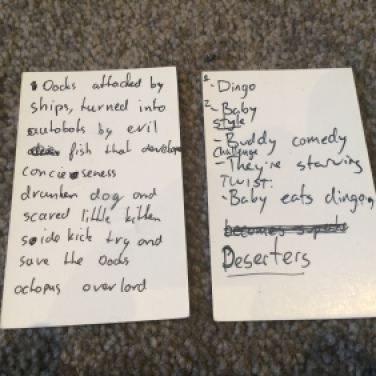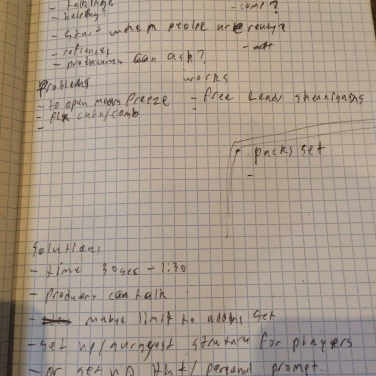Name/Game Title – pitch it, crunch time, make this happen, pitch me this, etc
Idea- a pitch game based around film. Think cards against humanity but pitching the ideas as films.
Plot/story – the next big film is being sought and the producers have called in the team to make it big. You and your friends will be competing to please the producers needs and make the next great film or just play to the producers and make the next (please insert your “favourite generic money grab film” here)
Idea Generation – Started with the theme of film and went on to wanting to make an asymmetrical or pitch game.
Research of other games – Cards against humanity, Big ideas, Coup, Say anything, Mysterium. These all influenced what mechanics and type of game I wanted to make with mysterium being the reason I wanted an asymmetric game but games like Cards against humanity and big ideas lead me to more of a pitch like game that would be more fun to develop for a first game.


Production of the game
TimeLine
Initial idea of both an asymmetrical game and a pitch/cards game. This then lead to meeting with a group of friends to decide which type of game was more interesting. With them I played big ideas to look into pitch games and how to implement the mechanics. From there I worked with them to come up with the core of the game and then play tested the game with that group. Took notes from that and went and did another play test soon after that with a different group of friends.
The next thing that came up was the pitch to the class and their feedback helped to refine my ideas. Later I Play tested in class and the idea changed again from the previous two play tests.
The prototype used some old business cards my brother had around to build the genre and settings decks for the base game. I had some card around for note taking when pitching and then added the black token form what Chris provide to represent the producer in this prototype.


Basic anatomy list
- One producer token
- Deck of cards that are separated into categories such as
- Genre (base)
- Setting (base)
- Theme (addition/ expansion)
- Characters (addition/ expansion)
- One liners (addition/ expansion)
- Quotes (addition/ expansion)
- Optional word cards for players to make notes for their pitch
Mechanics overview
- Prodcer role
- Draw two cards form deck
- Mediate pitch
- Picks winner of round
- Player roles
- Comes up with pitch
First draft/edition
Producer gets a deck of genre and settings and plays the top cards, players are asked to free form a pitch with these cards. You get 1-2mins to come up with ideas.
Additional ideas that came off this was a hint system or something extra to help generate a place to start
Second draft/edition
This one had the same producer setting but added the aspect that the producer adds a plot point or other idea to add to the pitch. Then players can answer instantly or wait till others answer.
Setup
Shuffle each deck separately (base only has genre, setting, others like characters and one liners can be added later). Decide who will be the producer first (say who ever has watched a movie the last), give them the black producer piece, and put them in front of them. If playing with pads for note taking give these to each play that wants them.
Basic rules
Play starts with the producer. The producer then picks up two cards from any deck and places them as the cards to pitch about while also having the option to add a twist if the producer wants. Players can then pitch straight away or wait and formulate their pitch. Once everyone has pitched then the producer decides who’s was the best and awards them a point. The role of the producer is passed onto the next person clockwise.
Additional Rules
- Producer can mess with the cards in the decks to stack something funny or bad for someone else.
- The producer can also add their own aspect to the outline such as it must include a dog.
Result of play test
Play test one
- Decided and formed the first prototype of the game with group of close friends and gamers
- found what worked with the prototype and what didn’t
- Examples being
- working start and ok core concept
- Not great flow with problems with timing and role problems
- Showed how personal ideas can break the game (example being how I want the free form pitch but that didn’t work for everyone and needed to be worked on as a mechanic
- Formed some early ideas for iteration and progression
Play test two
- Tested some of the ideas put forward in play test one
- Showed how difficult it is to play with people with vastly diverse levels of humour and background experience
- Also cemented that the roles and turns were too slow and needed to be changed to get the game to work
Play test three
- Vasty changed the game due to good input and constructive feedback
- Main points are the change from set time to open answer
- More interaction
- More decks
For more comprehensive look see blog post in appendix
Market
Target market is somewhere between a casual gamer to non-gamers, probably aimed to be able to be played by most but the main target will probably be film makers and other creative people that would then intro the game and play against others.
Basic idea of cost
Cards decks of 20-40 – base set of genre and setting at 30 each. Probably go with drive though cards if just playing with these decks. With this I will have to also include another few cards for instructions and additional ideas. Based on the site if 100 decks of 60 Euro poker-size cards/deck (Standard) = be $350 ($3.50/deck). This leads to one way to put out the cards. If I was to explore this again with a more realist release I would test different card sizes as the thought is If all they have a smaller card might be better to make the decks more playable. This leads on to art and graphics. If I was to note down what I need out of this it would mainly need text on cards to be readable around a table while also being identifiable as different decks. I could probable use a minimalist graphic design like cards against humanity and have different card colours to split the decks. If I was to release this I would hire a graphic designer to make give it a logo.
If I was to add things like a few tokens and dice then a box might be needed and would have to go through a different site that would help make the box and tokens. Could also add an instruction manual/ ways to play the game differently
Another aspect to think about will be if I wanted to make decks expansions or add some form of betting to how the wins are made so that the competitive side gets a bit more focus. The betting tokens would fall under the box idea while the decks could go a few routes. One being licensed expansions and the other being open source with the ability to have people come up with decks they want to use and share them online. The first one would come under the drive through cards production. The second idea would be less market base and more just sharing the game, though I like the idea of having a game that had online iterations that could make it unique and probably more repayable from that.
If I was to sum up the game I would say the game is ok but needs work to be done to make it marketable/distributable. This would probably be done by overhauling the main core of the game or tweaking the theme to have a bit more creative freedom so it’s not so slow. Right now, it’s more of an ice breaker/ group activity than a game.
Appendix
Play test blog
The first play test was more a formative playtest. It started with my group (my brother and a group that I like to play board games with) helping pin down the best ideas in the two games I had put in front of them and then working with them to knock up a basic prototype. This play test brought up what worked and what didn’t. Starting with what worked play started ok with the decks working most of the time and the aim to leave it free from worked to allow for some nice shenanigans. Problems that came up were slow play due to the long turn times with the producer being impacted the worst with nothing to do in the time, people that didn’t feel like they could come up with much on the spot, and the difficulty of picking a winner based on evaluation seemed difficult and very biased to the point where none were picked on occasions. These problems were a subject of how I had structured the game and thus I needed to change some things. Things that were suggested were a hint system to help players struggling to play in the set time which would give the producer something to do. Other ideas were producer can talk during the pitch time and give what they would want or ideas (tied in with the hint idea) and they could also mess with the decks to stack them in favour or against people (or just pick the best combinations for the next producer).
 left first play test,
left first play test, other ideas
other ideas
The second play test was more of the same but with a smaller and slightly different group of players, namely my dad and sister. This test had some of the ideas from the last play test implemented such as the hint/ producer twist to help get people going. While this idea of hints worked reasonably well one big problem was my sister and my dad had vastly different ideas and backgrounds and thus some ideas got over looked because of that, an example being my dad playing a highly political pitch and my sister not getting it one bit. Ideas thrown around were to base time pitched with money, only having one pitch not two, adding notes to other players pitch which could lead to a much more cooperative game. This test showed that I need to figure out how to make the game more engaging while also not alienating players, figure out how to score more constantly. Nailing down what mechanics is enough (hints or additions) and making the role of the producer more productive and not too passive.
The last one was in class and made the most changes to the game. The group played one or two rounds of the old draft but found the problems from the other tests. Someone suggested that it might be good to play without the set time to respond and thus the game moved from the set time to more just pitch when you want to. This made the game more spontaneous and help with flow. We also played that with the producer setting an additional idea/hint with the cards drawn. this changed the game to be more a game and less of a task and thus I think made it more fun to just make up bull shit to meet the outlandish ideas of what the producer could come up with.
Pic of play test and played pitch/cards here












